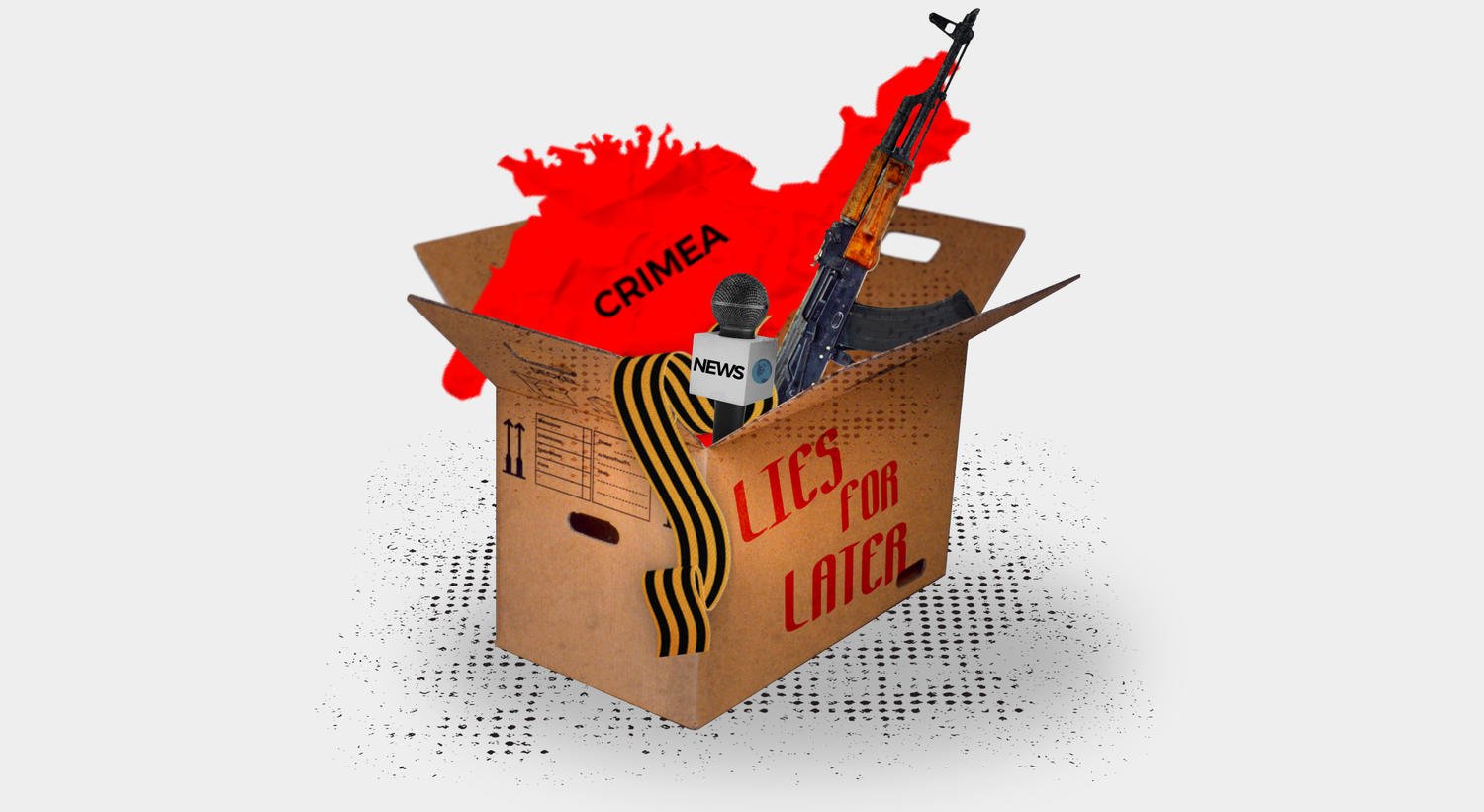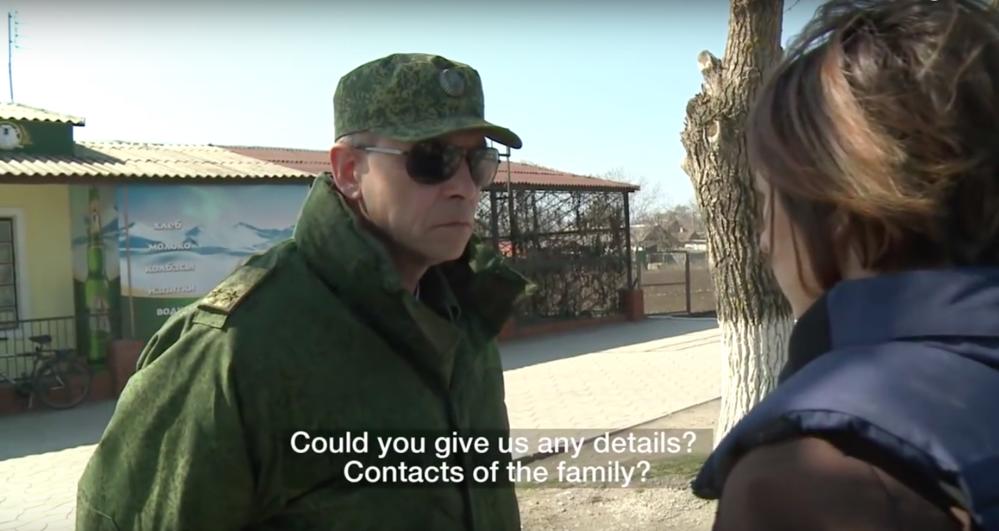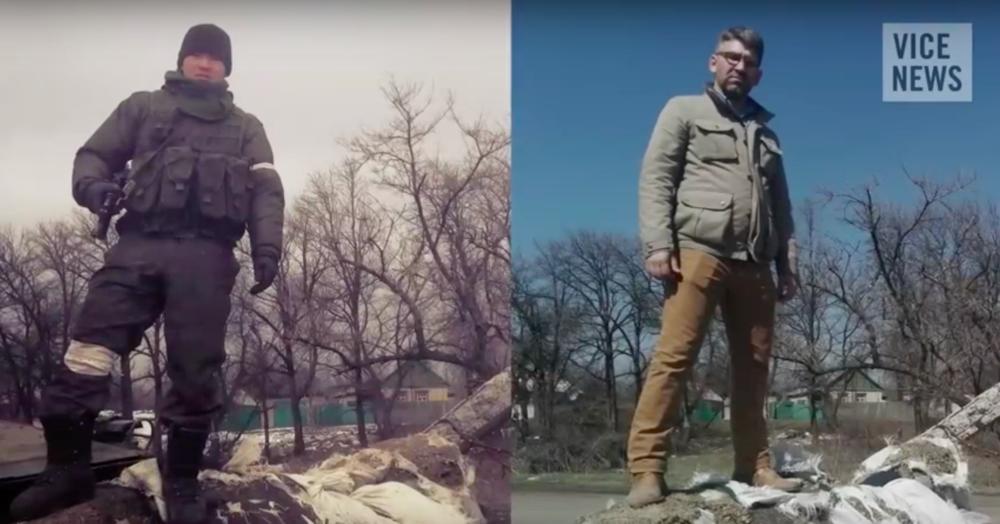
As journalists try to figure out how to cover a “post-factual” world, they should look at Ukraine for lessons
On March 12, 2014, long before anyone could imagine Donald Trump becoming President of the United States and concepts of “fake news” and “alternative facts” turning into global buzzwords, a group of journalists gathered outside a Ukrainian military base in Perevalnoe, outside Simferopol, the regional capital of Crimea. Standing next to several dozen screaming protestors, the journalists, many of them from Russia, watched how hundreds of soldiers armed with Kalashnikovs and light antitank missiles and wearing balaclavas and brand-new insignia-free uniforms, lined up along the perimeter of the long concrete fence surrounding the base.
The events unfolding in Crimea were so bizarre, so unprecedented, none of us journalists quite knew how to describe them. Later, Russian channels would call it “re-unification” and the rest of the world would label it annexation but at the time no one could be quite sure what Putin’s game in Crimea was. The Russian media, however, seemed to have been under strict orders. “Do these soldiers look like volunteers to you?” a chain-smoking Russian TV journalist in Perevalnoe asked me, crowning the rhetorical question with an elaborate profanity.
Minutes earlier I had overheard him on his phone with the editor in Moscow after his TV crew lost their live link to the studio. The editor told him the link had been cut because the reporter called Russian soldiers Russian soldiers and that he would either have to stick to “volunteer battalions” or leave Crimea. “I am ashamed,” said the journalist, who asked me not to name him. But from then on, following his editor’s and Vladimir Putin’s lead, he would only refer to the Russian troops in Crimea as “self-organized volunteer battalions.” A mortgage and three children, he explained to me, is what made him stick to the lie.
Western journalists covering Crimea and the subsequent war in Eastern Ukraine did not have to make difficult moral choices, but they too were pushed into an alternative reality constructed by the Kremlin, and involuntarily aided its narrative. Fast forward three years and today we live in the world where “post-truth” is a real word and alternative reality has spread far beyond the borders of the former Soviet Union. Whether it is covering the effects of Brexit on the NHS or politicians in Washington who now present “alternative facts,” reporting on lies is more than ever part of the job description of many journalists. And as journalists find their way in our post-fact, post-truth world, they should learn from the mistakes the Western media made in Ukraine.
The Ukraine conflict became a real challenge to the accepted rules of Western-style “objective” reporting. Balance is at the core of Western journalism, which teaches reporters to present multiple sides of the story and to make sure that all their reporting is based on information that can be verified. But the Ukraine conflict, more so than any crisis before it, showed that unless this quest for balance is accompanied with in-depth, committed, nuanced reporting, it works against the larger goal of providing an accurate picture of what is going on.
The reason why Ukraine became the litmus test for international media was because it was the first crisis truly saturated with lies and disinformation from all sides. Of course propaganda, and fake news have always been part of any conflict, but in the era of information overload, where every opinion has a platform, disinformation reached an entirely new level.
The international media did not seem to be ready for the disinformation assault. With a flurry of press-releases, statements and interviews the Kremlin skilfully disputed the facts on the ground, and the Western media used the Kremlin’s lines to provide “balance” to those facts on the ground. Unlike Russian journalists, most of my colleagues from the Western media outlets did not use Vladimir Putin’s “volunteer self-defence unit” term to describe the Russian soldiers, but very few actually called them what they were: Russian troops. Instead they used more obscure terms like “unidentified soldiers” or “little green men.” This, academic Marta Dyzhok argues, means that as a result the media failed to frame the story clearly, allowing allowed disinformation to shape the narrative. In other words, unwillingly the international media endorsed a lie.
Dyzhok writes, “The choice of images, terminology, information presented or omitted in many international media reports is one reason that the entire issue of what happened in Crimea, how, why, and the results, are still subject to debate. To an uninformed audience, it was not evident whether Russia was protecting ethnic Russians from an illegitimate fascist, right-wing government in Kiev, or whether Russia was invading a neighbouring country. The fact that Crimea’s legitimately elected government was deposed at gunpoint was not highlighted, yet plenty of attention was devoted to the event called a referendum a few weeks later.”
The Ukrainian conflict was, by no means, underreported. It was covered extensively albeit with, typical for the media, lulls in between outbursts of coverage when the global media attention moved elsewhere. However, despite some outstanding pieces of reportage, for the most part Western media simply juxtaposed two opposing narratives, without going deeper or finding hard evidence of lies on either side.
Of course, lack of depth and superficiality are accusations made about journalism on virtually every subject, and the media often has very legitimate reasons to be superficial. The very nature of large-scale news operations on breaking news stories lends them to superficiality: reporters are rotated in and out of the conflict, while on the ground they are asked to file constant updates and their reporting is complimented, or balanced, with arrays of studio interviews that offer plenty of opinions. But in the age of the constant onslaught of alternative opinions, facts and information, this proved to be a dangerous way to operate.
“Perhaps the greatest shortcoming in international reporting was that the causes of violence were not adequately explored.” Dyzhok argues that the same applied to the coverage of the Maidan protests which proceeded Crimea saying that “dramatic images of clashes were widely circulated, and made it onto many top-photos-of-2014 lists. (However, the overwhelming majority of protesters were peaceful, creative, and only a small extreme element advocated violent methods. The radicals caught the attention of the cameras, as did their slogans and nationalist insignia). But few reports were asking the question: “who instigated the violence?”
The first lesson of Ukraine is that in the era when information is a weapon, “who” and “why” should take priority over of journalism’s other Ws: “when” and “what.” It is asking the “who” and “why” questions that allow journalists to cut through noise and lies, go beyond superficiality of the daily news cycle, to report in-depth and to confront “fake news” head on.
And this is also where Ukraine offers its second lesson. Today, as media professionals and experts debate “fake news” some ask whether confronting fake news is necessary at all? In an article “Is fake news a fake problem?” Jacob Nelson, a PhD candidate at Northwestern University argues that according to his research, fake news audiences remain extremely small and users of “fake news” sites often visit other, legitimate media sources.
But Nelson’s own conclusion is counter-intuitive to his argument, writing that “If half of the fake news audience had been approaching both real and fake news for the past year with an open mind, you would expect that audience to shrink as readers eventually abandoned fake news sites. That this has not happened suggests the fake news audience isn’t reading real news because they believe it might also be accurate, but because these sources are popular and they want to know how the rest of the world “falsely” understands current events. If this is indeed the case, it means solving the fake news problem will be much trickier than limiting its supply.”
Nelson notes that so far, solutions to fake news problems focus on myth-busting and fact-checking websites. “Facebook recently integrated fact-checking into its publication process, while Google no longer allows Google- served advertising to appear on sites that “misrepresent” information.” Others focus on improving journalism: BuzzFeed Editor-in-Chief Ben Smith has advocated for more support for objective, accurate reporting as a way to counterbalance the fake news creeping its way across social media feeds.
But Ukraine showed that none of this is enough. The danger and power of fake news, whether state-funded like it is in Russia or commercially driven as it often is with sites in the United States, is that it distorts reality, introduces doubt and undermines legitimate arguments. If in the Soviet time’s the Kremlin’s goal was to get people on its side, these days the goal is to make them think that “everyone else is bad.” Fake news designed for click-bait may have a different goal, but ultimately they have the same effect: they muddy fact-based narratives, create alternative realities, maim truth and allow politicians to call anything or anyone “fake news.”
In Ukraine very few Western reporters made an effort to investigate the greatest triggers of violence: the lies, from both sides, which helped to fuel the conflict. As the Ukrainian media responded to the Kremlin’s information war with its own, a lot less sophisticated and much more chaotic propaganda onslaught, the Western media chose to stay out of it. It seemed as if the international media organizations never asked themselves the question which is topping their agenda now: How do we cover lies? In the case of Ukraine: how do we show the correlation between the lies broadcast on television and the battle unfolding on the ground. Balanced reporting is not enough to cover the murky, slippery subject of disinformation, and as I found out for myself it is only when journalists get in to specifics that a lie can convincingly be de-bunked.
For a long time, amid constant live updates covering the war for the BBC, I did not have the time and resources to focus on the disinformation element of the war, even though I was always acutely aware of how the hatred broadcast on Russian TV screens led to bloodletting on the ground. That parallel reality was also less of a priority for my editors, who were more interested in clearer, more easily digestible, newsier stories of gun-battles and protests. But in April 2015, while buying a quick snack in a supermarket in Donetsk my producer Abdujalil Abdurasulov and I overheard two women discussing a devastating rocket attack that killed a 10-year-old girl in the city’s suburbs. The women were understandably angry with the Ukrainian troops (“the neo-nazis” as they referred to them) who had fired the rocket.

The story had been picked up by all Russian channels and we decided to look into it as well. There was a slight lull in news at the time, which allowed us to spend a couple of days on the story — an unbelievable luxury in the world of daily news. The rebel spokesperson Eduard Basurin, confirmed the death of the girl to us and the area where she was killed, but he refused to give the family’s address, so we then spent hours looking for them in the area where the attack had allegedly taken place. When we didn’t find any traces of the family or the attack, we went to hospitals and the city’s morgue that should have received the body of the girl. They had not. Eventually, we approached Russian television crew that had reported on the story and they confessed, on camera, that “the girl never existed” and that they broadcast the story because “they were told to.”
The piece on the Donetsk girl that never existed ended up being one of the BBC’s most watched TV pieces from Eastern Ukraine, with almost two million views on Facebook alone. By the time the piece had aired, Vladimir Putin had himself debunked his own lie of “volunteer battalions” by admitting that they were indeed Russian troops. It cemented the narrative of “Russian disinformation” within the Western media mind-set, but the fact that the ultimate de-bunking was done by Putin himself also de-legitimized it. I have not been able to find a single piece of journalism that managed to trace a “little green man” in Crimea to his hometown in Russia.

Later on, the pieces that provided specific, vivid, character-based examples of this disinformation remained few and far between. Among the most notable examples was an excellent investigation by Simon Ostrovsky for Vice News which traced a story of an alleged “volunteer soldier” in Eastern Ukraine back to his military base in Buriatia, Russia. What made Ostrovsky’s reportage so effective and so widely watched was the fact that it went beyond stating that “Russians lie,” instead it asked “who” and it explained “why.”
This, I believe, is the only way that the media can counter the menace of fake news. It is only through specific characters that media can break through the fog of generalities which is the oxygen that disinformation breathes. If fake news thrives on characters that don’t exist, like Syrian refugees who rape girls in Frankfurt, then reporting that counters them should too rely on specific, compelling characters that debunk these myths.
This is the kind of journalism that requires the most commitment and resources, but without which we will continue to present to our increasingly sophisticated audiences simplified and ultimately misleading narratives about the world.
In Ukraine, lack of these questions ultimately led to the victory of “fake news” over real news. Of course, Russian disinformation did not convince global public opinion that all Ukrainians were “neo-nazis,” but it never meant to. It won because it stripped the Western media of its ability to frame the crisis clearly.
Perhaps the greatest lesson of Ukraine is that without editorial commitment to in-depth, nuanced reporting on complex crises, the media will continue to sink deeper into its own echo-chamber, polarizing societies rather than informing them and endorsing fake news instead of proving them what they are: lies.
Natalia Antelava, for Coda Story
Natalia Antelava is the editor-in-chief of Coda Story.
This essay was originally published by The Foreign Policy Center.





